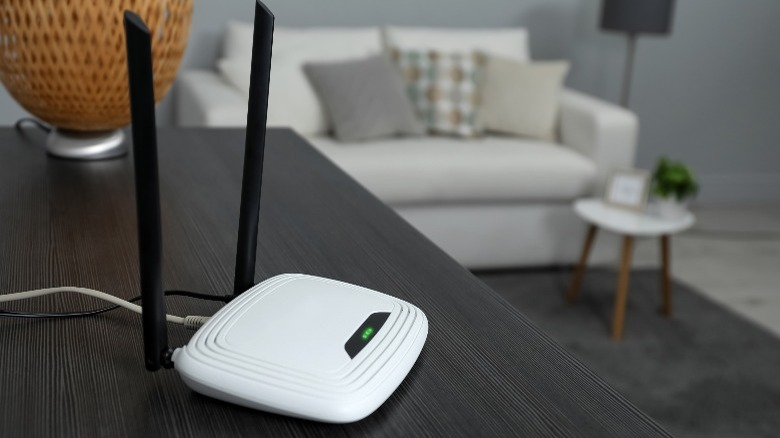2.4 GHz Vs. 5 GHz Wi-Fi: Which Should You Use?
If you've had an internet connection installed in your home, had to replace a Wi-Fi router, or simply connected to the Wi-Fi network at your favorite café in the last decade, you might have noticed two available networks: 2.4 GHz and 5 GHz. But what exactly does this mean, and which should you use? These numbers denote the frequency the network operates at, and which one you choose can have an impact on your overall experience, or you may not notice a difference at all. It all depends on what you're doing.
Every few years, the Institute of Electrical and Electronic Engineers develops an updated Wi-Fi standard for public use; often bringing speed upgrades, bumping up security, or adding fancy new features. The 5 GHz Wi-Fi frequency has been around for a long time, although initial adoption was quite slow — partially thanks to delayed availability of home routers that support the 5 GHz band. At this point most Wi-Fi routers are dual-band, supporting both 2.4 GHz and 5 GHz, with some even adding the newer 6 GHz and Wi-Fi 6E into the mix as well. According to a report by the Wi-Fi Alliance and ABI Research, 5 GHz Wi-Fi reached the mainstream by 2015, a whole six years after the introduction of 2.4 GHz Wi-Fi routers.
What is 2.4 GHz Wi-Fi?
Introduced in 1999, the 2.4 GHz Wi-Fi — or IEEE standard 802.11b — has been the go-to for home use, with even modern dual and triple-band routers still carrying it forward to this day (per Network World). The 2.4 GHz standard has seen a number of revisions over the years; eventually ending up as 802.11g, or Wi-Fi 3, which expanded to the frequency range of 2.4 GHz, allowing it to reach greater speeds and theoretically cut down on interference between channels.
As the name suggests, it uses channels in the 2.4 GHz frequency, specifically in the 2401 to 2495 MHz range. Generally speaking, 2.4 GHz Wi-Fi has access to 14 channels with overlapping frequency ranges, and tops out at 54 megabits per second speeds — around 6.75 megabytes per second. While the speed might not be anything to write home about, it's certainly adequate for most basic home use cases. The range of 2.4 GHz Wi-Fi can exceed 150 feet, according to Pearson IT Certification, making it a great option for low-bandwidth and long-range applications.
What is 5 GHz Wi-Fi?
Introduced in 1999 as 802.11a, 5 GHz Wi-Fi surprisingly predates the 2.4 GHz variety, even though its mainstream adoption came much later (via Geeks for Geeks). Routers with 5 GHz support will be labeled as 802.11b/g/n, 802.11ac, or 802.11ax — with each having their own bandwidth limitations. The first 5 GHz network specification, 802.11a, ran at speeds up to 54 megabits per second — no faster than 2.4 GHz — while more recent standards using the 5 GHz frequency bumped speeds up to an incredible 2.4 gigabits per second (via Intel).
Modern 5 GHz Wi-Fi technology is capable of these immense speed increases because of how the network balances traffic, allowing more links to a device by enabling features like Multiple-User Multiple Input Multiple Output (MU-MIMO) (via Network World). Networks that use 5 GHz technology also have access to more, wider channels within the 5 GHz frequency spectrum, meaning interference is greatly reduced. Perhaps somewhat confusingly, the latest Wi-Fi revision that includes the 5 GHz frequency, 802.11ax, is also called Wi-Fi 6 — despite not including the 6 GHz frequency, although it does add a number of features to the 5 GHz Wi-Fi roster.
5 GHz is faster, but 2.4 GHz has longer legs
As mentioned before, 5 GHz networks are far faster than their 2.4 GHz counterparts, but that speed comes at a cost. Because 5 GHz uses a shorter wavelength to transmit data, it's far more susceptible to signal degradation. Networks operating over 2.4 GHz, on the other hand, have a much longer range, reaching up to 230 feet indoors, whereas a 5 GHz Wi-Fi network is limited to around 115 feet, according to a Litepoint whitepaper. Those range figures for 5 GHz Wi-Fi look even worse when you start talking about houses built with denser materials like concrete.
While wired connections are still king in terms of speed and latency, the speed boost of 5 GHz over regular 2.4 GHz connections makes it worth adapting your setup a little bit. That's especially true if you're in a situation where you need to work from home, or you want to do competitive online gaming.
Find a balance between range and speed
The network you choose depends largely on what you need to do, and you could even conduct some trial and error to find a sweet spot for your Wi-Fi router. If you have many devices connecting to the same network over Wi-Fi, and your router supports dual band, connect high-bandwidth devices like laptops, TVs, and smartphones nearby the router to the 5 GHz network, and connect devices in other rooms or floors to the 2.4 GHz network. Low-bandwidth devices could be things like smart plugs, lightbulbs, or even Wi-Fi cameras.
Try to minimize devices on the 2.4 GHz network, since that tends to get crowded, and can lead to interference (via Shaw). If you're desperate for 5 GHz speeds, you could try relocating your router or getting an extender. If you're out and about, the answer is far simpler — connect to the fastest network available to you. By this point, most restaurants that offer Wi-Fi will have dual-band routers, and the reduced interference and increased speeds of 5 GHz make it a no-brainer in those situations.




